What Is a Barcode? How It Works, Benefits, and Common Uses
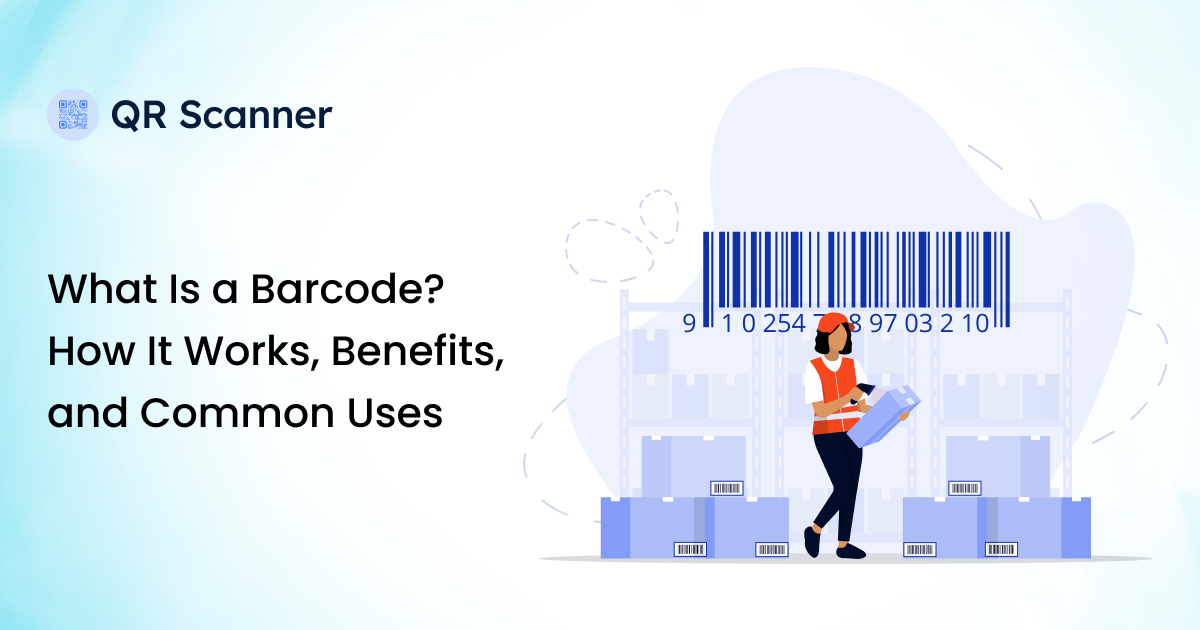
Barcodes - we come across them almost every single day. Like grocery items in supermarkets, books inside library shelves, or a parcel at the doorstep, all these have barcodes printed on them. These codes might seem like ordinary lines to you, but for businesses, they play a vital role. They help in organizing and tracking items more effectively. In this blog post, you will be learning what barcodes are, how they work, and how they benefit businesses.
What Is a Barcode?
A barcode consisting of bars, spaces, and parallel lines is a method of representing data in a visual form that is machine-readable. Traditionally, barcodes with stripes varying in length and space are referred to as linear and 1D, meaning one-dimensional barcodes.
Information in the form of numerics and readable characters is embedded inside these codes. This information can be decoded by scanning the barcode with a special optical scanner or an online barcode reader tool.
Where Barcodes Started - The History Side
In the 1940s, two young inventors, Norman Joseph Woodland and Bernard Silver, sought ways to speed up checkouts. One day, an idea struck them when Woodland drew lines in the sand using the Morse Code dots and dashes. He stretched the dots and dashes into thin and thick bars, trying to create a new way to store information. This is where the journey to barcodes started and travels as follows (Information source: Wikipedia):
- 1952 - Norman and Bernard patented their idea in the US. However, the idea still took twenty years to be put into practical use.
- 1960s - Industries began experimenting with barcode-like systems. For example, British Railways developed a scanner that could read codes on moving trains.
- 1970s - George Laurer designed a vertical bar code that was printed clearly.
- 1972 - A UK supermarket chain, Sainsbury’s, tested barcodes on shelves. They showed the retail world what was possible.
- 1973 - The Uniform Grocery Product Code Council officially chose Laurer’s barcode design.
- June 26, 1974 - A pack of Wrigley’s chewing gum became the first product scanned with a barcode at a supermarket in Ohio.
And that is where the real checkout revolution in shopping and inventory management started. Fast forward to today, and barcodes have spread everywhere. In fact, the rise of smartphones in the 2000s has given rise to an advanced form of barcodes, namely 2D barcodes, also known as QR (Quick Response) codes.
How Do Barcodes Work?
The mix of black lines and white spaces on barcodes contains embedded information that machines can read instantly. The working of barcodes begins with the encoding of data within. Data can be any information, such as a product number, price, or ID.
By encoding, or more specifically, by creating a barcode, this information is transformed into a pattern of bars (in 1D barcodes) or boxes and dots (in 2D barcodes).
To read, or more accurately, to decode this information, traditionally, specialized optical scanners were used. When a barcode is scanned using them, a laser beam is shed that is sensitive to the reflections. The black bars absorb light while the white spaces reflect it.
By reflecting light, the scanning device translates the code into digital data and transfers it to a connected device, which can be anything, such as a laptop, PC, or tablet. The computer system processes it, and numbers are matched with information stored in a database.
Components of a Barcode
Various components come together to form a precise barcode. These include:
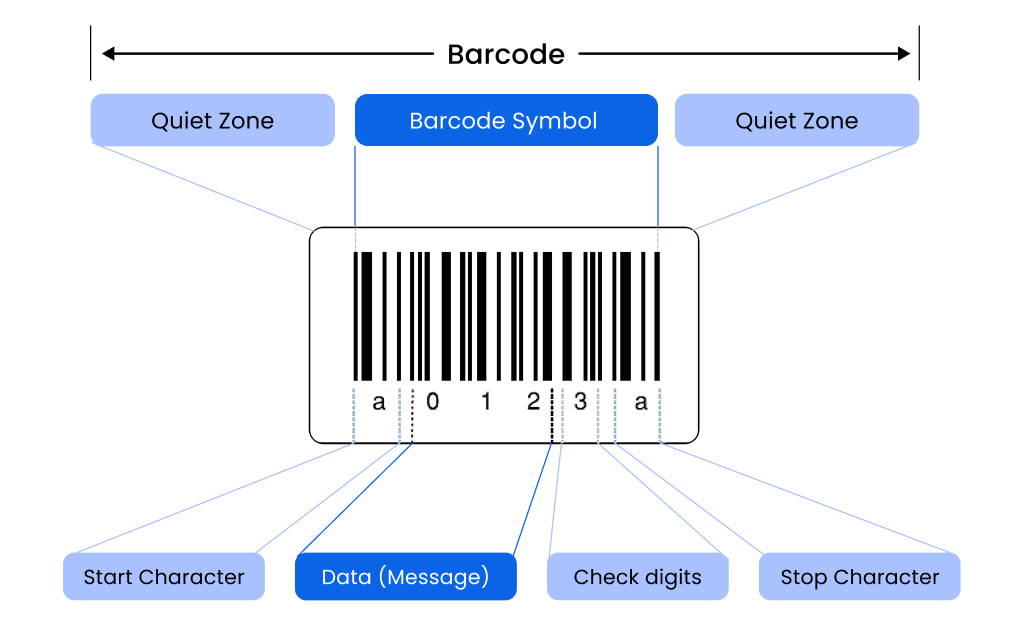
- Quiet Zone: It is the blank space between the black margins of a barcode.
- Number System Digit: It refers to the first digit on the barcode. This number represents the category of the product as indicated by the UPC code.
- Start/End Character: These characters indicate the starting point and the ending point for the data, respectively.
- Check Digit: This is the digit that helps ensure the data is encoded correctly within the barcode.
- Manufacture Code: It is a group of characters after the first digit and is used to identify the manufacturer.
- Product Code: This is another set of characters after the manufacturer's code set and is used to identify the specified product.
Standards Used for Barcodes
Many people get mistaken by barcodes, as they come from a single centralized standard. However, in reality, barcodes come in many formats, referred to as symbologies. Each is designed for a different industry and purpose.

For a better understanding, we have provided an overview of fifteen of the barcode standards commonly used in practice below.
- Uniform Product Code (UPC): It is the most widely used barcode standard and is employed extensively across retail stores for checkout and inventory management.
- Code 39 (Code 3 of 9): Primarily used in the shipping industry for tracking purposes.
- POSTNET: The U.S. mail service uses this standard for encoding zip codes.
- European Article Number (EAN): This standard is a superset, like the UPC, and is used for identifying countries.
- Japanese Article Number (JAN): This one is similar to EAN, but mainly used in Japan.
- Bookland: This standard serves as the basis for ISBNs, which are often printed on the book's cover page.
- ISSN barcode: Uses ISSN numbers and is mainly found in magazines and journals outside the U.S.
- Code 128: Preferred over Code 39 because it can store the same data in a smaller space.
- Interleaved 2 of 5: This standard is also used in the shipping industry and warehouses for tracking purposes.
- Codabar: Used in libraries and blood banks, mostly by Federal Express.
- MICR (Magnetic Ink Character Recognition): A special set with a special ink that is used to print codes on financial instruments.
- OCR-A: Optical character recognition format used on book covers to display the ISBN in a readable way.
- OCR-B: Used to show human-readable numbers for other standards such as UPC, EAN, JAN, Bookland, ISSN, etc.
- Maxicode: This code standard is in use by the United Parcel Service.
- PDF417: A 2D barcode standard that is commonly used on IDs, boarding passes, and government documents.
Different Types of Barcodes
Barcodes are usually categorized into two main types:
1. 1D Barcodes (Linear Barcodes)
These are the classic black lines and white spaces you see on most products. They store information in a horizontal direction, such as a product name, number, or color. They usually involve the use of the following barcode standards:
- UPC (Universal Product Code)
- EAN (European Article Number)
- Code 39
- Code 128
- ITF (Interleaved 2 of 5)
2. 2D Barcodes
Instead of just vertical lines, these types of barcodes use patterns of squares, dots, or other shapes. Additionally, they store data both horizontally and vertically, allowing for the storage of significantly more information.
Below are some of the standard 2D barcodes.
- QR Code: Can store website links, text, or contact info. Widely used because smartphones can scan them easily.
- Data Matrix: Very compact, often used in electronics and healthcare.
- Aztec Code: Common in airline boarding passes and transport tickets.
Benefits of Barcodes for Businesses
Barcodes may seem simple, but they offer significant benefits to businesses across all industries. The following are some of the common benefits:

Faster Operations. Scanning a barcode is significantly quicker than manually entering numbers. It helps speed up checkout and inventory processes.
Better Accuracy. Manual data entry often results in errors, particularly at checkout counters with high volumes of customers. Barcodes reduce human error and ensure records are more reliable.
Cost-Effective. Printing barcodes is inexpensive, and once set up, they save businesses money by reducing errors and wasted time.
Easy Inventory Management. From tracking stock levels to monitoring product movement, barcodes make managing inventory much simpler.
Improved Customer Experience. Faster checkouts and accurate pricing mean happier customers and smoother shopping experiences.
Common Uses of Barcodes Across Industries
Many people are mistaken about barcodes, as they are limited to being on product tags only. In reality, they are utilized by numerous industries for various purposes. Here’s how different industries make use of them:
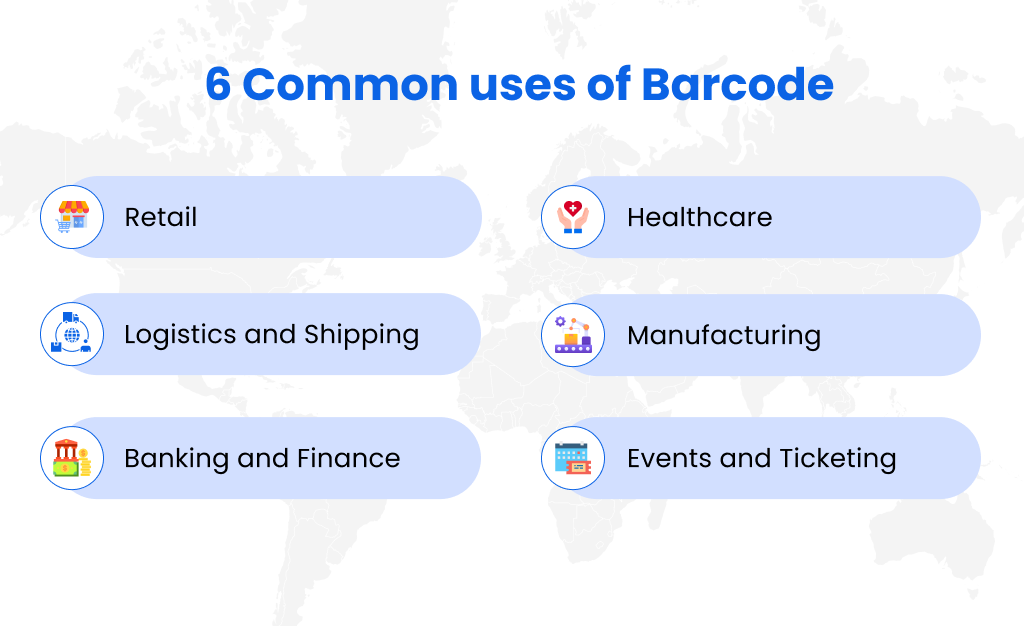
1. Retail
There is no doubt that the biggest application of barcode at the time lies in the retail industry. In fact, barcodes have enabled retailers to automate many of their repetitive tasks.
As an example:
Instead of manually entering a product number and its price, retailers now access the information with a single scan. This is especially useful for them at the checkout counter.
Furthermore, it enables faster billing, making both the employee and the customer happy. Additionally, it minimizes the chance of human error that might occur when typing manually.
2. Healthcare
Hospitals and clinics rely on barcodes for patient safety. Wristbands with barcodes store patient identity details, which are crucial, especially for newborns.
Moreover, barcodes help in ensuring that doctors and nurses administer the correct medication to the right person.
Pharmacies also scan barcodes on medicines to prevent errors and confirm authenticity. Even lab samples are tracked with barcodes, reducing the risk of mix-ups.
3. Logistics and Shipping
Barcodes are also heavily used in the logistics and shipping industries. You may have also noticed that shipment receipts provided by courier companies typically have a barcode printed on them.
In fact, such businesses use them from booking a shipment to the last stage of delivering it to the recipient. Moreover, barcodes are used in warehouses to quickly locate items, thereby speeding up order fulfillment for e-commerce companies.
4. Manufacturing
Factories use barcodes to track raw materials and monitor each step of the production line. This ensures that parts and components don’t get lost, and defective items can be traced back to their source.
5. Banking and Finance
If you have ever gone to deposit or debit a cheque in a bank, you have noticed that bankers do not type the information manually. In fact, they just scan the barcode printed on the cheque. With an instant scan, they can access the necessary account information to proceed further.
Barcodes, such as MICR and OCR standards, are used on checks, bills, and other banking instruments. They expedite processing, minimize paperwork errors, and contribute to maintaining security in financial transactions.
6. Events and Ticketing
Barcodes are now also used on tickets for various events, including concerts, travel, and sporting matches. Tickets with barcodes help businesses prevent duplicate allotments/sales.
Additionally, barcodes help speed up the entry process at gates, protecting people from having to stand in long lines. Moreover, many event organizers use them to track attendance in real-time, making the entire process smoother.
Different Methods to Read Barcodes
There are various methods that you can use to read/decode the information inside barcodes. The following are three key among them.
Online Barcode Scanner (Fast, Easy, Efficient)
The easiest, fastest, and most efficient way to decode the information inside the barcode is to use an online barcode scanner. This is because you can instantly decode the data using the online tool on your smartphone device or PC/laptop.
Online barcode scanners have eliminated the need for specialized equipment/scanners such as optical scanners.
To read the barcode easily, you can either scan the code in real-time using a webcam. Alternatively, you can take a picture of the barcode and upload it to the tool to get the information decoded instantly.
Optical Scanner (Efficient but Hardware Dependent)
Before the invention of online barcode scanners, fixed or handheld specialized optical scanners were used. As mentioned earlier, these devices use laser beams to detect the contrast between black bars and white spaces, then translate that into digital information.
Optical barcode scanners are highly efficient and accurate. But they do require physical hardware, which makes them less flexible compared to online solutions.
Human Method (Difficult to Implement)
As humans, we can also read the barcodes on our own. But the process is quite complex. Here’s how you can read a barcode manually:
- Identify the type of barcode you have to read.
- Obtain the symbology chart for that barcode type. This chart illustrates how patterns of bars and spaces represent numbers.
- Locate starting and stopping patterns.
- Measure bar and space widths.
- Decode digits using the chart.
- Identify data segments and lastly verify the check digit.
While this process technically works, it is slow, error-prone, and impractical for everyday use. That’s why barcode scanning has shifted almost entirely to digital tools and scanners.
Final Talk
Beginning as an experiment in the 1940s, the barcode has evolved significantly. Due to their accuracy, they are now widely adopted across various industries.
They help them streamline processes, making them faster and more cost-effective. With multiple standards, types, and easy scanning methods, barcodes continue to simplify how businesses manage data and serve customers. We hope that this blog post has helped you understand barcodes, their working, types, and common uses.
Related Blogs
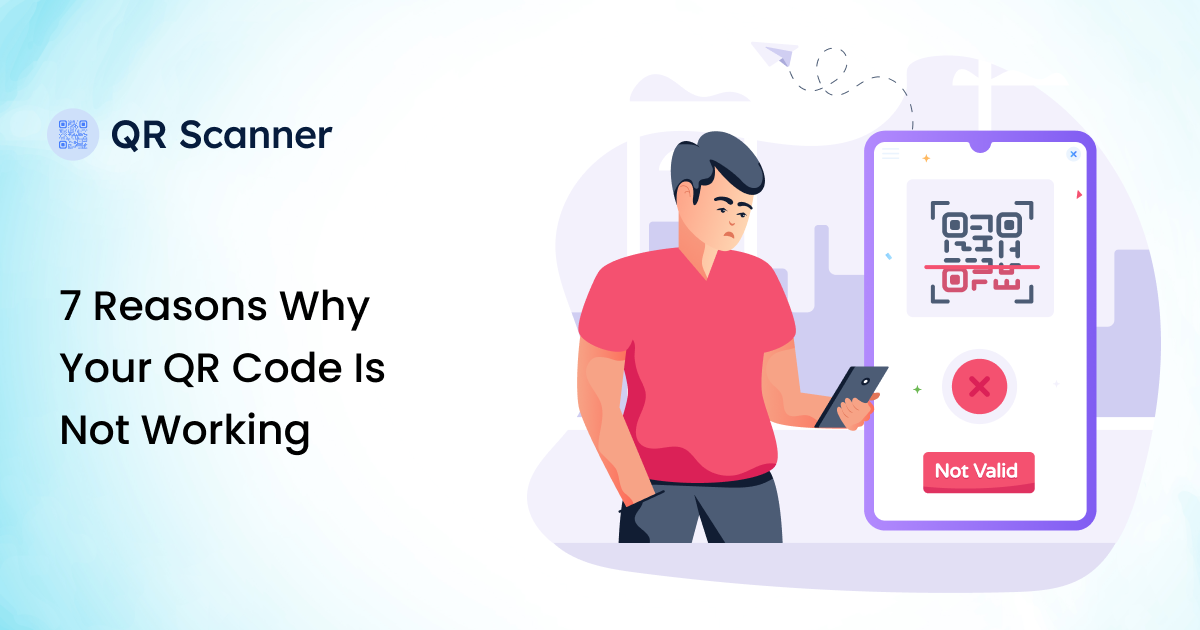
7 Reasons Why Your QR Code Is Not Working
Learn our comprehensive guide on seven reasons why your QR Code is not working
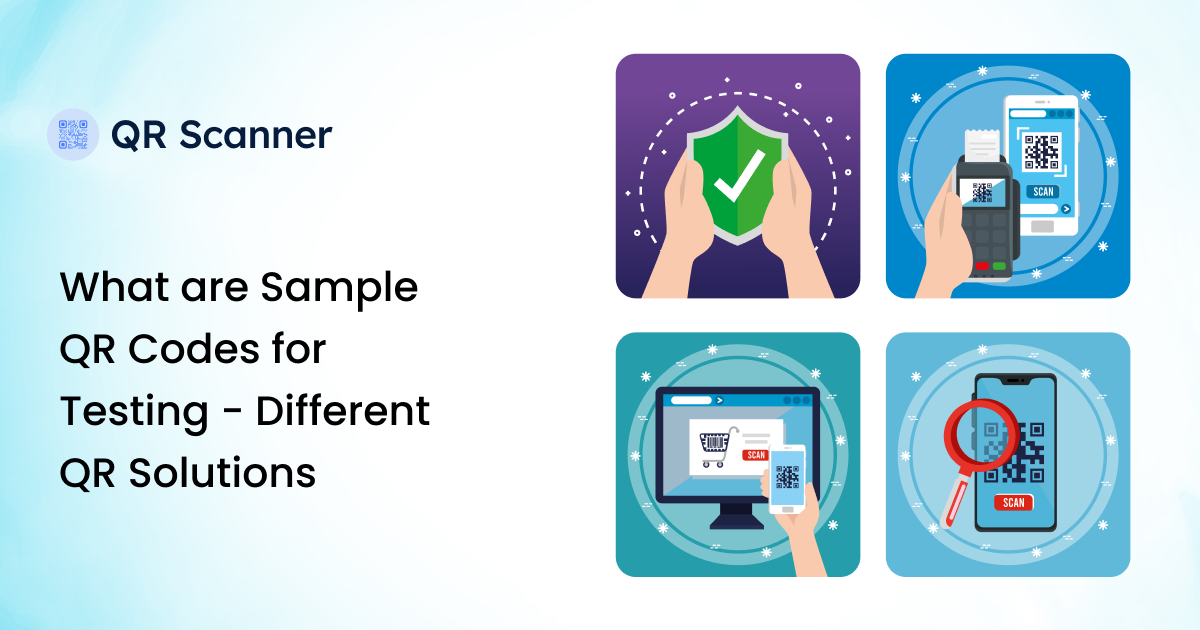
What are Sample QR Codes for Testing - Different QR Solutions
Learn about what are Sample QR Codes for Testing - Different QR Solutions

5 QR Code Tactics for Maximizing Marketing Engagement
Follow these five powerful QR code tactics to Boost your marketing engagement